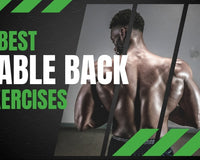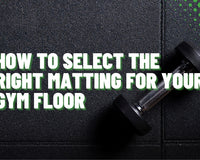Keeping your rubber gym flooring clean ensures a hygienic workout environment and prolongs its lifespan.
The type of rubber flooring you have will determine how much elbow grease you need to use to clean the floor but the steps are mostly the same.
If you have a rubber crumb flooring they tend to hang on to dirt a little than the smooth finish EPDM rubber flooring tiles.

Equipment Needed to Clean Rubber Gym Flooring
To clean your rubber gym flooring you will need the following basic cleaning equipment:
- Buckets: Just to hold on to the cleaning solution and water, you'll want two different buckets. You may also use a single bucket divided into two containers.
- Mop: Exactly the type of mop you choose depends on your specific flooring, something we'll cover further below. However, the point here is that you need a mop so you can wet wipe the rubber gym flooring.
- Broom/ Vacuum: Before you can mop, you'll need either a broom or vacuum to remove any physical and solid debris that is dry and not stuck on.
- A Soft Brush: You'll also want a soft-bristled brush so you can do a bit of spot cleaning for any stains. Just be sure that you aren't using anything overly abrasive.
- Floor Cleaner: Finally, you'll need some kind of floor cleaning solution. There are plenty of rubber floor cleaners designed for commercial purposes. There are also DIY rubber floor cleaners that you can make with just some water and dish soap.
How to Clean a Rubber Gym Floor: Step-by-Step
Now that we have gathered all of the materials you'll need to clean your rubber gym floors, let's get to it and clean them as well as we can.
Step 1: Sweep and Vacuum the Floor

You don't want to start right by mopping the rubber gym flooring, because all you'll do is push around a bunch of dust and debris. Therefore, the better solution is to first sweep or vacuum the entirety of the ground to pick up as much debris as you can.
You want to get that dirt out of there. Any dust, sand, or other particles should be removed before you start mopping.
Now, if you happen to have a home gym in your garage, or even a commercial gym, using a leaf blower to simply blow the dust away is an option at your disposal.
While you are vacuuming or brooming the ground, try to keep an eye out for any spots that might need any special attention.
There's no right or wrong way to go about this, as long as physical debris is removed. Once you are satisfied, you can then move on to the next step.
Step 2: Get Your Cleaning Solution
Next, you're either going to have to buy or create a cleaning solution. Of course, you can buy some kind of commercial-grade rubber floor cleaner.
These can be somewhat expensive, but the bonus is of course that you don't have to do any mixing yourself. They are ready to go.
With that being said, if you want to save a bit of money and go with something more eco-friendly, you can always create a DIY rubber floor cleaner. However, the number one thing you need to keep in mind here is that a rubber floor cleaner should be neutral in terms of pH.
In other words, it should not be acidic. It should have a neutral pH level of 7.0.
If you're making your own DIY rubber floor cleaner, more often than not, some hot water and dish soap is more than enough. If you need something to get rid of extra tough stains and deodorize, a bit of baking soda should do the trick.
The main point here is that you need to avoid harsh chemicals. Anything like Lysol, bleach, or anything else of this sort needs to be avoided at all costs. These could damage your rubber floors, and should therefore not be used.
Related Post: How Thick Should Gym Flooring Be?
Step 3: Start by Spot Cleaning

Before you start mopping your whole rubber gym floor, it's a good idea to do a bit of spot cleaning, use your cleaning solution, a soft bristle brush, and maybe a cloth to attack the most troublesome areas.
If you see any stains that are on the floor, ones that likely won't be removed with a simple mopping, now it's time to do spot cleaning. If there are any extra dirty areas, this is the time when you want to address them.
Those trouble spots are usually in areas that see the most traffic, so pay attention to those. You don't want any spilled sugary drinks around, because not only are those sticky, but they attract pests as well.
Step 4: Mop the Floor
Ok, so now that you have done some spot cleaning and vacuuming, it's time to mop the ground.
We will touch on the exact type of mop you should use further below, but the point here is that you should have a mop, a wash bucket with your cleaning solution, and a rinse bucket that has just plain water.
Remember, you need to rinse the floor after washing it with the cleaning solution, because you don't want to leave any of the cleaning solution behind.
So first, put your mop in the wash bucket and then wring it out. You want the mop head to be relatively moist or damp, but not soaking wet.
If you soak your rubber floors, you might damage them, and at the very least, it's a pain to clean up. You also don't want any water seeping through the rubber floors down to the subflooring below, as this can cause damage over time.
Mop the floor using circular motions, and continuously clean off the mop head. You want to dunk the head of the mop in the rinse bucket to get as much of the cleaning solution and dirt off of it as possible.
Remember, if the head of your mop is dirty, all you'll end up doing is pushing around dirty water on your rubber gym floors.
Keep mopping the ground in a circular motion, rinsing the mop head, dipping it back in the cleaning solution, and scrubbing those mats until you've covered the whole ground.
Now, if you used a DIY cleaning solution, you may not have to rinse afterwards. However, even with DIY solutions that contain dish soap, you don't want to leave any residue behind.
Therefore, whether you use a DIY cleaning solution or a commercial-grade rubber gym floor cleaner, now is the time when you want to rinse.
Get a clean bucket of water, and a clean mop head, and go over the whole floor one more time just to make sure that there is no residue left behind.
All throughout the process, remember that you need to keep changing your wash or rinse water.
You'll notice that the water slowly becomes very dirty. Once again, if you rinse your mop head in dirty water, it's not really getting clean at all, and you'll just push more dirt around the ground.
Therefore, every now and again, as both your cleaning solution and rinsing water get dirty, pour them out and make new batches.
You'll know when it's time to change the cleaning solution and the rinsing water because it will be visibly dirty. Of course, how often you'll need to go through this process depends on how much floor you have to cover.
Related Post: Guide to installing rubber gym flooring.
Step 5: Let the Floor Dry

The final step here is to allow the floor to dry. Now, if you've got the floor extremely wet, you might want to use a dry mop head or even a towel just to soak up some of the excess water. Time is of the essence if you used too much water, because once again, you don't want it seeping through down to the subfloor below.
With that being said, if the floor isn't totally soaked, you can just let it air dry. The best case here is that you will allow the floor to dry for 24 hours so that it is totally wet.
You don't want to start working out on a wet floor. If the floor is still wet and you walk on it, any dirt on your shoes will stick to it. Moreover, there is also a risk of slipping if you are working out on a wet floor.
The Best Type of Mop for a Rubber Gym Floor
What you need to realize is that there are slight differences between rubber gym floors, and also different mops.
Exactly which model you use depends on a variety of factors, with the exact type of rubber you have being one of them. Let's take a quick look at different types of mops you can use to clean your rubber gym floor.
- Flat Head Mop: The first type you can choose is the flathead mop. These have a flat rectangular head with a microfiber cover. You don't need a bucket for this, as they usually have compartments on board that house cleaning solution that you can spray out. They're good for basic daily cleaning, although they don't do well for scrubbing.
- Sponge Mop: Next, we have the sponge mop. This is simply a sponge with a wringer. These are just like regular kitchen sponges. These are ideal for mopping in straight lines, although they're also not the best for scrubbing.
- Strip Mop: Next on the list we have the strip mop. These have synthetic fibers that are formed into strips, along with wringers to wring out the water. Working in a figure-8 pattern as opposed to straight lines is recommended when using this type of mop.
- String Mop: Similar to strip mops, string mops are made with natural fibers. This is your classic mop. They can be a bit difficult to get dry enough to effectively clean a rubber floor, so this is best avoided.
- Floor Scrubber: You can always choose an automatic floor scrubber as well. These are ideal for large spaces, although probably overkill if you just have a small home gym.
Sealing Rubber Gym Floors
If you want, you can always seal your rubber gym floors with special rubber floor sealant. These are generally used in commercial areas, although you can always do this at home as well.
Sealing your floors will make them much more water and stain resistant, and therefore easier to clean.
To seal rubber floors, all you have to do is follow the cleaning process that we have described above and then apply the sealant in small sections as instructed by the manufacturer.
What About Bleaching a Rubber Gym Floor?
Bleach will likely damage rubber, especially over a prolonged period of time. That said, bleach is ideal for disinfecting. If you are going to use bleach, only use 1/3 of a cup with one gallon of water, and make sure to work in a well-ventilated area.
Rounding Up

The bottom line here is that with a few simple tools and basic cleaning solution, you can clean those rubber gym floors and get them looking like new. Remember to do so regularly, or else they'll end up smelly and sticky!





